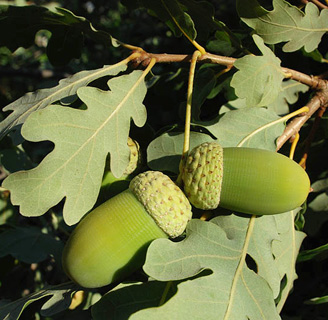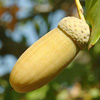Quercus robur (Common oak, English oak, French oak, Pedunculate oak) is a long-lived deciduous tree. Several individuals are among the oldest broad-leaf trees known in Europe: one tree in Lithuania and another in Bulgaria are more than 1,500 years old, according to the number of annual rings in their trunks.
Pedunculate oak can reach a height of 25 m. The diameter of the trunk at breast height of the largest tree of this species, which is also the tree with the widest trunk in England and is known as Majesty Oak, is 3.90 m.
The bark of pedunculate oak is grooved, tuberculate and grayish-brown. The wood of pedunculate oak is known for its strength and its durability. This wood was therefore used in the past for building ships and houses. It is still used as high-quality wood for furniture and construction. The name of the species, robur, means “strong wood” in Latin, and expresses the main use for this wood. Pedunculate oak forests served as an important source for essential raw material throughout Europe for a long time. Today, these trees are planted mainly in parks and gardens in temperate regions, where hybrid trees with other oak species and varieties with unique crowns are used.
The leaves of pedunculate oak are alternate and are carried on short petioles. The sprouting leaves are light green to reddish and change color to dark green upon maturation. Before exfoliation, the leaves turn yellow in trees that are planted in high regions and reddish-brown in lower and warmer regions. Various domesticated varieties of pedunculate oak are characterized by strong and conspicuous sprouting and fall colors. The leaves have lobes which are small at the base and at the tip of the leaf and long in the center.
In Israel, pedunculate oak blooms in March. The male flowers are limp catkins and disperse the pollen by wind. The female flowers are a small nutlet which grows in size inside a cupule. The acorn is an elongated nutlet which broadens from the base upwards. There is a small protrusion at the upper apex of the nutlet. Upon ripening, the nutlet becomes reddish-brown. The cupule is glabrous, somewhat scabrous, and is very short compared to the length of the nutlet and only covers its base. The nutlets are dispersed by animals, in Europe mainly by squirrels and birds. Its name, pedunculate, apparently originates from the long pedicels on which the acorns are carried.
The question is sometimes asked, what is the difference between English oak and pedunculate oak? The answer is that this is the same species, and today botanists do not differentiate between them even as different subspecies. Indeed, the populations of Pedunculate oak in the Caucasus, in Anatolia and in southeast Europe were in the past defined with other synonyms, such as: Quercus brutia, Quercus pedunculiflora, Quercus haas, but today they are regarded as belonging to the same species.
Seeds of pedunculate oak were brought to Israel from Anatolia, and perhaps also from the Balkans. Surprisingly for a tree from temperate regions, it is relatively resistant to drought and soil salinity and is therefore very successful in Israel as a planted ornamental tree. In Israel it is planted in groves, boulevards and domestic gardens in deep soil, in Mediterranean regions, without additional irrigation. The KKL (Jewish National Fund) adopted it as an ornamental tree in parks which it plants and sometimes even uses it as a forest tree in suitable habitats in the Mediterranean regions.
Pedunculate oak belongs to the Fagaceae family. The name of this family originates from the genus Fagus, a type of tree that does not grow in Israel at all. However, we can find parts of this tree in furniture made of beech, which is the commercial name of the wood which is produced from Fagus sylvatica.
Written by Zvi Avni





